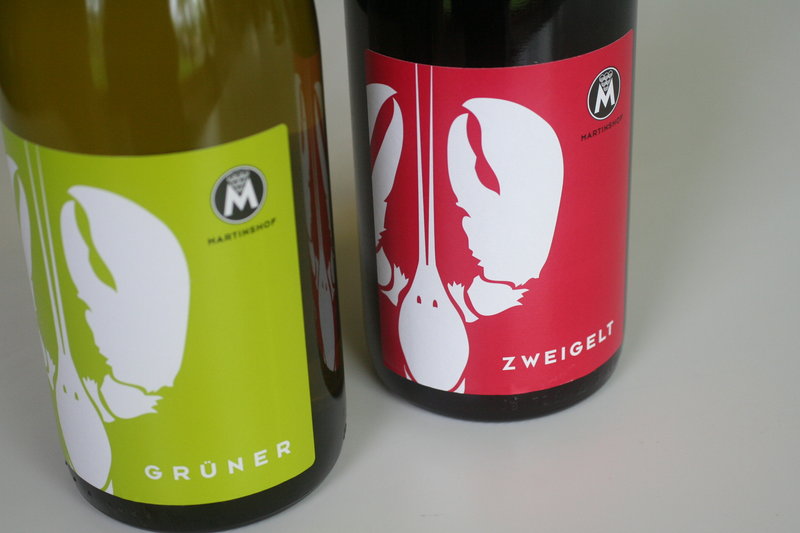I like Gruner Veltliner OK, but I’ve never been as enamored of it as some people. I’ve tasted a couple of Gruners that were fascinating, complicated affairs, but these were very expensive, so if that’s the only way I’m going to find the rapture, I’d rather pray at a different church.
Same goes for Zweigelt, a usually light-bodied red emphasizing cherry and raspberry fruit and easygoing, no-strings-attached charm. All right, that’s fine, but not especially interesting.
Theoretically, I should love GV and Zweigelt straight up, because the grapes are a) high-acid and delicate, respectively; b) Austrian; c) enjoying a hipness phase; d) rarely oak-aged at the everyday affordable level; and e) difficult to pronounce.
Like all things hip, though, the star falls at some point when taste makers move on to the next thing. This move is currently under way — Assyrtiko or Mencia, anyone? — but that’s all the more reason now might be a good time to return to GV and Zweigelt and re-examine what they’re capable of.
Marketing moment-wise, I could have chosen better. Gruner emphatically does pair magnificently with both asparagus and artichokes, two spring vegetables for which it’s infamously difficult to find mates. Zweigelt, the graceful Pan-like creature that it is, entices when the weather turns warm and the living’s easy.
Michael Martin of lower Austria’s Martinshof appreciates this. Best known for the irresistible “Zum Martin Sepp” everyday liter-bottles of GV and Zweigelt, Martin came out with the “lobster label” wines earlier this year. The bottles of 2010 white and 2009 red have cool decals emblazoned with a white silhouette of a lobster. The message is clear: Drink this echt summer wine while eating this echt summer food. They got good press; sales were brisk.
When I got around to tasting the wines, though, I felt like the profiles are wrong for lobster. There’s too much lemony bite in the white, without the requisite fat to meet the lobster halfway; in the red well, c’mon, who drinks red with lobster? (It would be delicious with a juicy burger, I gotta say, and I’d love to see next vintage’s bottle emblazoned with a label sporting a burger silhouette.)
The wines are right-on, however, for a lot of other foods, and the key to this lies in the fact that despite the labels reading “Gruner” and “Zweigelt,” there’s something else going on. Specifically, the white has 5 percent Riesling, and the red has 5 percent Pinot Noir.
Doesn’t sound like much, does it? But this 5-percent solution makes all the difference. For all my love of freshness and acidity in white wines, I often feel that young Gruner needs a little romance in its life, a little love so it doesn’t come off too stern.
As so often is the case, Riesling saves the day. Incompletely fermented so as to leave a touch of residual sugar, it endows the wine with the barest hint of sweetness: The edges are softened; the frown turns upside-down.
Like a Sancerre or other well-made Sauvignon Blanc, which respects its limestone-terroir origins but offers some flesh to sheath the bone, the “Lobster Gruner” gains over its competitors in both fun and elegance. The trademark “greenness” of Gruner remains: Green olive, basil, mint, parsley, lime, green apple. These traits line it up for a lovely dance with olive-oil-based fish dishes, and of course herbs and leafy greens.
But again, that added layer of fat brought by the Riesling means that heartier steak-like fish, or a chicken Caesar salad, would be wonderful as well.
If the white will appeal to Sauvignon-Blanc lovers, think of the red as a Valpolicella or Beaujolais. Its “5 percent” is Pinot Noir, which brings a sliver of earth to Zweigelt’s bright red berries — earth, and also pepper and black-rock minerality. This is just what unoaked Zweigelt needs if it is to outmaneuver its “simple fun juice” pedigree.
The “Lobster Zweigelt” is supple, soft and real fun, but it’s not too tame or untethered. The Pinot adds a cleansing counterpoint of bitterness that elevates it past the realm of patio sipper. Bitterness might initially sound “bad” in wine (as does “sweetness,” to the ignorant), but in fact it’s a crucial component of reds especially, for it helps make the link to a crucial component of food. If you consider why roast chicken, grilled meat, bell peppers and wood-fired pizzas taste so good, you’ll appreciate bitterness more.
And you’ll appreciate this wine, especially if you add to the pairing list tomato sauce pastas as well as the aforementioned juicy burger.
Both wines, distributed by Wicked Wines, retail for around $12. They’re not for every single night of the week, and they’re not for cold winter nights.
They’re for right about now, though, and there’s no better way I can imagine to familiarize yourself with Austria’s two best-known and most widely planted varietals.
Joe Appel works at Rosemont Market. His blog, soulofwine.com, continues the conversation, and he can be reached at: soulofwine.appel@gmail.com
Send questions/comments to the editors.



Success. Please wait for the page to reload. If the page does not reload within 5 seconds, please refresh the page.
Enter your email and password to access comments.
Hi, to comment on stories you must . This profile is in addition to your subscription and website login.
Already have a commenting profile? .
Invalid username/password.
Please check your email to confirm and complete your registration.
Only subscribers are eligible to post comments. Please subscribe or login first for digital access. Here’s why.
Use the form below to reset your password. When you've submitted your account email, we will send an email with a reset code.